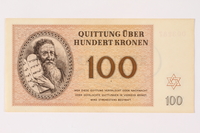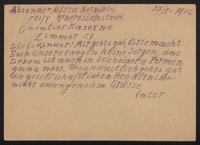Overview
- Brief Narrative
- Scrip, valued at 50 kronen, issued in the Theresienstadt (Terezin) ghetto-labor camp in 1943. All currency was confiscated from deportees upon entry and replaced with scrip and ration coupons that could be exchanged only in the camp. The Theresienstadt camp existed for 3.5 years, from November 24, 1941 to May 9, 1945. It was located in a region of Czechoslovakia occupied by Germany, renamed the Protectorate of Bohemia and Moravia, and made part of the Greater German Reich.
- Date
-
issue:
1943 January 01
- Geography
-
issue:
Theresienstadt (Concentration camp);
Terezin (Ustecky kraj, Czech Republic)
- Credit Line
- United States Holocaust Memorial Museum Collection, Gift of Edith and George Lauer
- Markings
- front, upper center, printed in blue ink : QUITTUNG ÜBER / FÜNFZIG KRONEN [RECEIPT OF / FIFTY CROWNS]
front, lower center, printed in middle text then above in blue ink : 50
front, lower center, smaller text than above, printed in blue ink : WER DIESE QUITTUNG VERFÄLSCHT ODER NACHMACHT / ODER GEFÄLSCHTE QUITTUNGEN IN VERKEHR BRINGT. / WIRD STRENGSTENS BESTRAFT [ANYONE WHO FALSIFIES OR DISTORTS OR FAKES THIS RECEIPT, OR COUNTERFEITS RECEIPT, WILL BE STRICTLY PUNISHED]
reverse, upper left in border, serial number, printed in red ink : 000579
reverse, right center below scrollwork, series number, printed in red ink :
reverse, center, printed in blue ink : Quittung / über / FÜNFZIG KRONEN [Receipt / of / FIFTY CROWNS]
reverse, lower center, printed in black ink : THERESIENSTADT, AM 1.JANNER 1943 DER ALTESTE DER JUDEN / IN THERESIENSTADT [THERESIENSTADT, ON 1. JANUARY 1943 THE ELDER OF THE JEWS IN THERESIENSTADT]
reverse, bottom right, printed in black ink : Jakob Edelstein - Contributor
-
Subject:
George Lauer
- Biography
-
George Lauer was a survivor of the Terezin ghetto and served as head of the ghetto sanitation department both prior to, and immediately following, liberation.
Physical Details
- Language
- German
- Classification
-
Exchange Media
- Category
-
Money
- Object Type
-
Scrip (aat)
- Physical Description
- Rectangular paper scrip. The front has a graphic design in black and blue/green ink on a blue/green background. The front depicts Moses holding 2 stone tablets with the 10 Commandments in Hebrew characters in a medallion on the left, with German text on the right. The right side has an off-white border with the denomination 50 in the lower corner with a 6-pointed Star of David above. The reverse has a blue/green geometric background design with German text, and a scrollwork line. Below the text is an engraved signature. The denomination 50 is in the upper right corner. The left side has a wide, off-white border with the denomination 50 in the lower corner with a 6-pointed Star of David above. The serial number is in the upper left corner. The series number is on the right, center under the scrollwork.
- Dimensions
- overall: Height: 2.750 inches (6.985 cm) | Width: 5.500 inches (13.97 cm)
- Materials
- overall : paper, ink
Rights & Restrictions
- Conditions on Access
- No restrictions on access
- Conditions on Use
- No restrictions on use
Keywords & Subjects
Administrative Notes
- Legal Status
- Permanent Collection
- Provenance
- The Theresienstadt scrip was donated to the United States Holocaust Memorial Museum in 1996 by the Estate of George Lauer.
- Record last modified:
- 2024-07-19 14:02:08
- This page:
- https://collections.ushmm.org/search/catalog/irn11322
Download & Licensing
In-Person Research
- By Appointment
- Request 21 Days in Advance of Visit
- Plan a Research Visit
- Request to See This Object
Contact Us
Also in Edith and George Lauer collection
The collection consists of scrip from Theresienstadt relating to the experiences of George Lauer as a prisoner in Theresienstadt ghetto/labor camp in German occupied Czechoslovakia during the Holocaust. The collection also includes three postcards from Liselotte Schulz (cousin of Edith Lauer) and Alfred and Anette Kornfeld (parents of Edith Lauer) while they were imprisoned at Theresienstadt.
Date: 1943

Theresienstadt ghetto-labor camp scrip, 1 krone note
Object
Scrip, valued at 1 krone, issued in the Theresienstadt (Terezin) ghetto-labor camp in 1943. All currency was confiscated from deportees upon entry and replaced with scrip and ration coupons that could be exchanged only in the camp. The Theresienstadt camp existed for 3.5 years, from November 24, 1941 to May 9, 1945. It was located in a region of Czechoslovakia occupied by Germany, renamed the Protectorate of Bohemia and Moravia, and made part of the Greater German Reich.

Theresienstadt ghetto-labor camp scrip, 2 kronen note
Object
Scrip, valued at 2 kronen, issued in the Theresienstadt (Terezin) ghetto-labor camp in 1943. All currency was confiscated from deportees upon entry and replaced with scrip and ration coupons that could be exchanged only in the camp. The Theresienstadt camp existed for 3.5 years, from November 24, 1941 to May 9, 1945. It was located in a region of Czechoslovakia occupied by Germany, renamed the Protectorate of Bohemia and Moravia, and made part of the Greater German Reich.

Theresienstadt ghetto-labor camp scrip, 5 kronen note
Object
Scrip, valued at 5 kronen, issued in the Theresienstadt (Terezin) ghetto-labor camp in 1943. All currency was confiscated from deportees upon entry and replaced with scrip and ration coupons that could be exchanged only in the camp. The Theresienstadt camp existed for 3.5 years, from November 24, 1941 to May 9, 1945. It was located in a region of Czechoslovakia occupied by Germany, renamed the Protectorate of Bohemia and Moravia, and made part of the Greater German Reich.

Theresienstadt ghetto-labor camp scrip, 10 kronen note
Object
Scrip, valued at 10 kronen, issued in the Theresienstadt (Terezin) ghetto-labor camp in 1943. All currency was confiscated from deportees upon entry and replaced with scrip and ration coupons that could be exchanged only in the camp. The Theresienstadt camp existed for 3.5 years, from November 24, 1941 to May 9, 1945. It was located in a region of Czechoslovakia occupied by Germany, renamed the Protectorate of Bohemia and Moravia, and made part of the Greater German Reich.

Theresienstadt ghetto-labor camp scrip, 100 kronen note
Object
Scrip, valued at 100 kronen, issued in the Theresienstadt (Terezin) ghetto-labor camp in 1943. All currency was confiscated from deportees upon entry and replaced with scrip and ration coupons that could be exchanged only in the camp. The Theresienstadt camp existed for 3.5 years, from November 24, 1941 to May 9, 1945. It was located in a region of Czechoslovakia occupied by Germany, renamed the Protectorate of Bohemia and Moravia, and made part of the Greater German Reich.

Theresienstadt ghetto-labor camp scrip, 1 krone note
Object
Scrip, valued at 1 krone, issued in the Theresienstadt (Terezin) ghetto-labor camp in 1943. All currency was confiscated from deportees upon entry and replaced with scrip and ration coupons that could be exchanged only in the camp. The Theresienstadt camp existed for 3.5 years, from November 24, 1941 to May 9, 1945. It was located in a region of Czechoslovakia occupied by Germany, renamed the Protectorate of Bohemia and Moravia, and made part of the Greater German Reich.

Theresienstadt ghetto-labor camp scrip, 2 kronen note
Object
Scrip, valued at 2 kronen, issued in the Theresienstadt (Terezin) ghetto-labor camp in 1943. All currency was confiscated from deportees upon entry and replaced with scrip and ration coupons that could be exchanged only in the camp. The Theresienstadt camp existed for 3.5 years, from November 24, 1941 to May 9, 1945. It was located in a region of Czechoslovakia occupied by Germany, renamed the Protectorate of Bohemia and Moravia, and made part of the Greater German Reich.

Theresienstadt ghetto-labor camp scrip, 5 kronen note
Object
Scrip, valued at 5 kronen, issued in the Theresienstadt (Terezin) ghetto-labor camp in 1943. All currency was confiscated from deportees upon entry and replaced with scrip and ration coupons that could be exchanged only in the camp. The Theresienstadt camp existed for 3.5 years, from November 24, 1941 to May 9, 1945. It was located in a region of Czechoslovakia occupied by Germany, renamed the Protectorate of Bohemia and Moravia, and made part of the Greater German Reich.

Theresienstadt ghetto-labor camp scrip, 10 kronen note
Object
Scrip, valued at 10 kronen, issued in the Theresienstadt (Terezin) ghetto-labor camp in 1943. All currency was confiscated from deportees upon entry and replaced with scrip and ration coupons that could be exchanged only in the camp. The Theresienstadt camp existed for 3.5 years, from November 24, 1941 to May 9, 1945. It was located in a region of Czechoslovakia occupied by Germany, renamed the Protectorate of Bohemia and Moravia, and made part of the Greater German Reich.

Theresienstadt ghetto-labor camp scrip, 20 kronen note
Object
Scrip, valued at 20 kronen, issued in the Theresienstadt (Terezin) ghetto-labor camp in 1943. All currency was confiscated from deportees upon entry and replaced with scrip and ration coupons that could be exchanged only in the camp. The Theresienstadt camp existed for 3.5 years, from November 24, 1941 to May 9, 1945. It was located in a region of Czechoslovakia occupied by Germany, renamed the Protectorate of Bohemia and Moravia, and made part of the Greater German Reich.

Theresienstadt ghetto-labor camp scrip, 50 kronen note
Object
Scrip, valued at 50 kronen, issued in the Theresienstadt (Terezin) ghetto-labor camp in 1943. All currency was confiscated from deportees upon entry and replaced with scrip and ration coupons that could be exchanged only in the camp. The Theresienstadt camp existed for 3.5 years, from November 24, 1941 to May 9, 1945. It was located in a region of Czechoslovakia occupied by Germany, renamed the Protectorate of Bohemia and Moravia, and made part of the Greater German Reich.

Theresienstadt ghetto-labor camp scrip, 100 kronen note
Object
Scrip, valued at 100 kronen, issued in the Theresienstadt (Terezin) ghetto-labor camp in 1943. All currency was confiscated from deportees upon entry and replaced with scrip and ration coupons that could be exchanged only in the camp. The Theresienstadt camp existed for 3.5 years, from November 24, 1941 to May 9, 1945. It was located in a region of Czechoslovakia occupied by Germany, renamed the Protectorate of Bohemia and Moravia, and made part of the Greater German Reich.

George Lauer papers
Document
The George Lauer papers include three postcards from Liselotte Schulz (cousin of Edith Lauer) and Alfred and Anette Kornfeld (parents of Edith Lauer) while they were imprisoned at Theresienstadt. Alfred Kornfeld died in Theresienstadt, Anette Kornfeld was transferred to Warsaw and perished in unknown circumstances, and Liselotte Schulz is believed to have been killed in one of the death camps.



